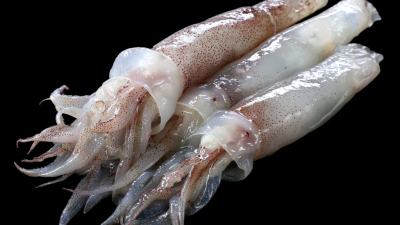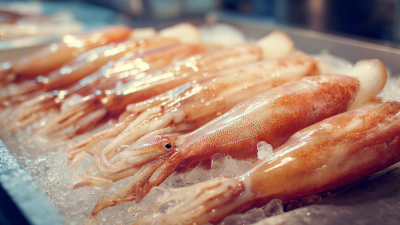Frozen Squid Tentacles are not just a convenient ingredient; they are a culinary treasure trove brimming with versatility, nutrition, and flavor. In recent years, these delightful marine morsels have made their way into kitchens around the world, captivating home cooks and seasoned chefs alike. From their unique texture to their ability to absorb various flavors, frozen squid tentacles can transform everyday meals into extraordinary delights. In this article, we will explore the amazing benefits of incorporating frozen squid tentacles into your culinary repertoire, including tips on preparation methods, cooking techniques, and creative recipe ideas. Whether you’re looking to enhance a simple stir-fry or impress your dinner guests with an exotic dish, frozen squid tentacles are a must-have for any kitchen, unlocking endless possibilities for delicious meals.

Frozen squid tentacles are a nutritional powerhouse that can significantly enhance your culinary repertoire. Rich in protein, omega-3 fatty acids, vitamins, and minerals, they provide numerous health benefits, including supporting heart health and promoting muscle growth. Adding frozen squid tentacles to your meals not only boosts their nutritional value but also introduces unique flavors and textures, making them an exciting ingredient for a variety of dishes.
In today's fast-paced world, the demand for fresh, nutritious foods has never been higher. Traditional preservation methods often fall short, leading to a growing interest in frozen ingredients, such as squid tentacles. These offerings maintain their nutritional integrity while being convenient and versatile for home cooks. Whether grilled, stir-fried, or added to soups, frozen squid tentacles allow culinary enthusiasts to create delicious meals without compromising on health benefits, ensuring that every bite is packed with flavor and nutrition.
Thawing and preparing frozen squid tentacles can seem daunting, but with a few essential tips, you can master this versatile ingredient. According to the National Fisheries Institute, squid is not only low in calories but also rich in protein and omega-3 fatty acids, making it a nutritious addition to any meal. When thawing frozen squid, it’s best to do so slowly in the refrigerator overnight to preserve its texture. Quick thawing under cold running water is another effective method, but avoid using hot water, which can compromise the quality.

Once thawed, squid tentacles can be easily prepared through various cooking methods such as grilling, frying, or stir-frying. A study published in the Journal of Food Science suggests that marinating squid tentacles prior to cooking can enhance flavor and tenderness; try a simple marinade of olive oil, garlic, and lemon juice for a delicious result. Moreover, the seafood industry has reported that incorporating squid into your diet can contribute to sustainable eating practices, as they are abundant and have a lower environmental impact compared to other seafood options. By using frozen squid tentacles, not only do you save time and ensure freshness, but you also support sustainable seafood practices.
Frozen squid tentacles are a versatile ingredient that can elevate your meals in numerous ways. They can be easily incorporated into various culinary traditions, making them a fantastic choice for innovative recipes. For example, you could create a delectable squid stir-fry with a medley of colorful vegetables and a savory sauce, perfect for a quick weeknight dinner. Alternatively, a crispy fried calamari can impress your guests as a classic appetizer, showcasing the delightful combination of crunchiness and tender squid inside.
Another delicious option is to use frozen squid tentacles in a refreshing salad. Grilling the tentacles can bring out their rich flavors, especially when paired with fresh green beans and a zesty vinaigrette. For a comforting meal, consider making a squid pasta dish, with garlic, olive oil, and a touch of chili for an added kick. Whether you’re preparing for a festive occasion or simply experimenting in the kitchen, incorporating frozen squid tentacles opens up a world of exciting culinary possibilities.
When it comes to preserving the freshness of frozen squid tentacles, proper storage techniques are crucial. According to a report by the National Fisheries Institute, seafood can lose its quality significantly if not stored correctly, leading to texture and flavor degradation. Squid, known for its delicate taste and chewy texture, is best kept at temperatures below -18°C (0°F). Keeping it in a vacuum-sealed bag can help prevent freezer burn, which not only impacts the quality but also reduces the squids' nutritional value.
Tips for optimal storage: Always label your frozen squid tentacles with the date of freezing to ensure you use them within six months for the best flavor. Additionally, avoid repeatedly thawing and refreezing, as this can introduce bacteria and further compromise the quality. If you plan to use them in different meals, consider portioning them into smaller servings before freezing.
When you're ready to cook, remember to thaw the squid tentacles in the refrigerator overnight rather than leaving them at room temperature. This gradual thawing method preserves texture and minimizes moisture loss, allowing you to enjoy the full culinary potential of this seafood delicacy. Whether used in stir-fries, soups, or as a grilled dish, properly stored frozen squid tentacles can evolve your home-cooking experience.
Frozen squid tentacles are a culinary delight that can elevate a variety of dishes. Their delicate texture and subtle seafood flavor pair beautifully with ingredients such as garlic, olive oil, and chili peppers, creating a harmonious blend that excites the palate. A study by the Seafood Nutrition Partnership showed that incorporating seafood, like squid, into our diet can provide essential nutrients, including omega-3 fatty acids, which are crucial for heart health.

To enhance the flavor of squid tentacles, consider complementing them with fresh herbs like parsley or basil, citrus elements such as lemon zest, and a splash of soy sauce for an umami kick. The use of these ingredients not only brings out the natural sweetness of the squid but also enriches the overall dish. In fact, a report by the International Seafood Sustainability Foundation highlights that squid is underutilized in many cuisines, which presents an excellent opportunity for chefs and home cooks alike to explore its versatility in recipes ranging from stir-fries to gourmet salads.






